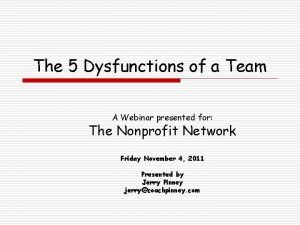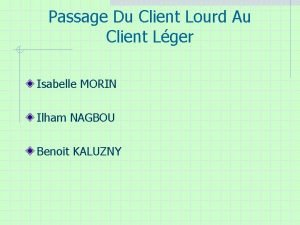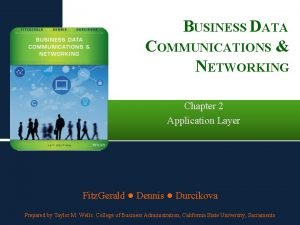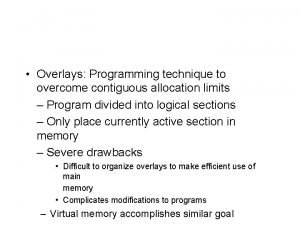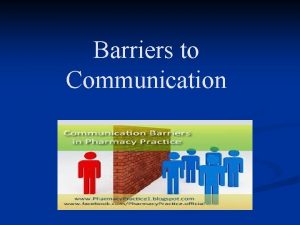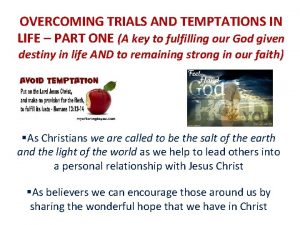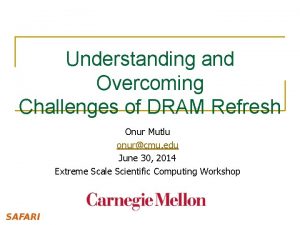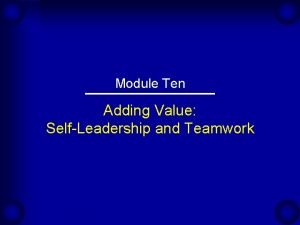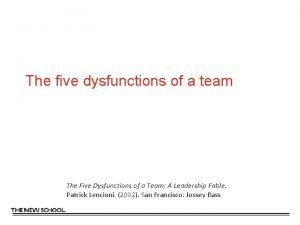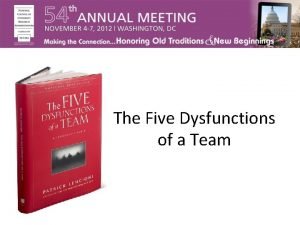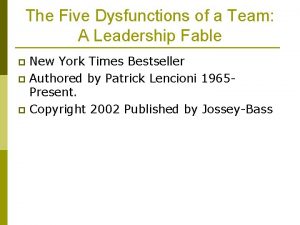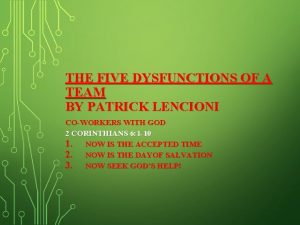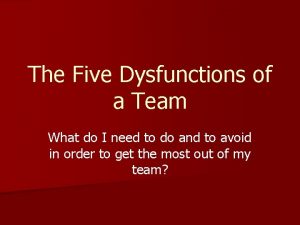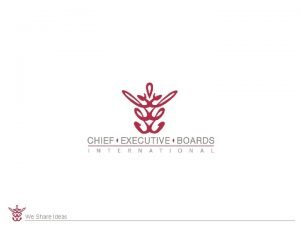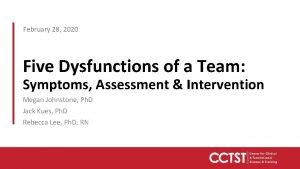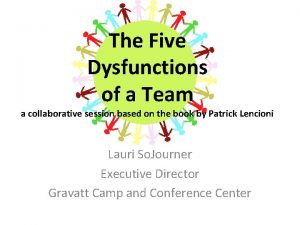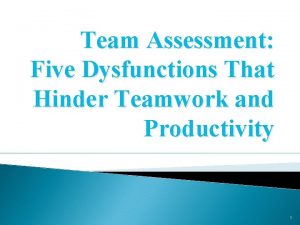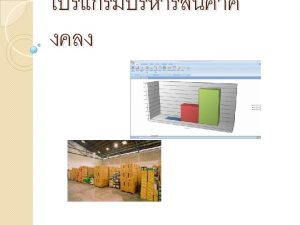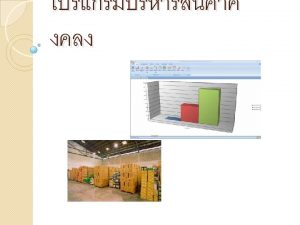Client Management Leadership Series Overcoming The Five Dysfunctions





































- Slides: 37

Client Management Leadership Series Overcoming The Five Dysfunctions of a Team Date Name The Table Group Consulting Partners www. tablegroupconsult. Ing. com

Overview Breaking Down The Four Disciplines Discipline 1: Build and Maintain a Cohesive Leadership Team Cohesive teams build trust, eliminate politics, and increase efficiency by… • • Knowing one another’s unique strengths and weaknesses Openly engaging in constructive ideological conflict Holding one another accountable for behaviors and actions Committing to group decisions Discipline 2: Create Organizational Clarity Healthy organizations minimize the potential for confusion by clarifying… • • Why the organization exists Which behavioral values are fundamental What specific business it is in Who its competitors are How it is unique What it plans to achieve Who is responsible for what Discipline 3: Over-Communicate Organizational Clarity Healthy organizations align their employees around organizational clarity by communicating key messages through… • • Repetition: Don’t be afraid to repeat the same message, again and again Simplicity: The more complicated the message, the more potential for confusion and inconsistency Multiple mediums: People react to information in many ways; use a variety of mediums Cascading messages: Leaders communicate key messages to direct reports; the cycle repeats itself until the message is heard by all Discipline 4: Reinforce Organizational Clarity Through Human Systems Organizations sustain their health by ensuring consistency in… • • • Hiring Managing performance Meeting structure Rewards and recognition Employee dismissal ©The Table Group, Inc. All rights reserved. Page 1

Building a Cohesive Team The Five Dysfunctions of a Team The Role of the Leader… Focus on Collective Outcomes Confront Difficult Issues Force Clarity and Closure Demand Debate Be Vulnerable #1: Absence of Trust #4: Avoidance of Accountability The fear of being vulnerable with team members prevents the The need to avoid interpersonal discomfort prevents team building of trust within the team. members from holding one another accountable for their behaviors and performance. #2: Fear of Conflict The desire to preserve artificial harmony stifles the occurrence of #5: Inattention to Results productive, ideological conflict. The pursuit of individual goals and personal status erodes the focus on collective success. #3: Lack of Commitment The lack of clarity or buy-in prevents team members from making decisions they will stick to. ©The Table Group, Inc. All rights reserved. Page 2

Building a Cohesive Team Overcoming The Five Dysfunctions Dysfunction # 1: Absence of Trust Strategy for Overcoming: · Identify and discuss individual strengths and weaknesses · Spend considerable time in face-to-face meetings and working sessions Dysfunction # 2: Fear of Conflict Strategy for Overcoming: · Acknowledge that conflict is required for productive meetings · Establish common ground rules for engaging in conflict · Understand individual team member’s natural conflict styles Dysfunction # 3: Lack of Commitment Strategy for Overcoming: · Review commitments at the end of each meeting to ensure all team members are aligned · Adopt a “disagree and commit” mentality—make sure all team members are committed regardless of initial disagreements Dysfunction # 4: Avoidance of Accountability Strategy for Overcoming: · Explicitly communicate goals and standards of behavior · Regularly discuss performance versus goals and standards Dysfunction # 5: Inattention to Results Strategy for Overcoming: · Keep the team focused on tangible group goals · Reward individuals based on team goals and collective success ©The Table Group, Inc. All rights reserved. Page 3

The Five Dysfunctions of a Team Table Discussion To which Dysfunction is your team most susceptible? __________________________________________________________________________________________ How does that Dysfunction manifest itself on your team? __________________________________________________________________________________________ Why are the Dysfunctions present on your team? __________________________________________________________________________________________ __________________________________________________________________________________________ ©The Table Group, Inc. All rights reserved. Page 4

The Five Dysfunctions of a Team Table Discussion How have the Dysfunctions impacted your team’s performance? __________________________________________________________________________________________ What could you do differently to address the Dysfunction on your team and drive results? __________________________________________________________________________________________ __________________________________________________________________________________________ ©The Table Group, Inc. All rights reserved. Page 5

The Five Dysfunctions of a Team Table Discussion Dysfunction: _______________ What tips do you have for overcoming your assigned Dysfunction? __________________________________________________________________________________________ __________________________________________________________________________________________ ©The Table Group, Inc. All rights reserved. Page 6

Building Trust The first requirement of a functional team is trust. Members of greats teams trust one another on a fundamental, emotional level and are comfortable being vulnerable with each other about their weaknesses, mistakes, fears and behaviors. They get to the point where they can be completely open with one another without filters. Personal Histories A low risk exercise to establish vulnerability-based trust. At a staff meeting or off-site, go around the room and have every member of the team explain 1) where they grew up, 2) how many kids were in their family, and 3) what was the most difficult or important challenge of their childhood (but not their inner childhood; just the most important challenge of being a kid!). Simply by describing these relatively innocuous attributes or experiences, team members begin to get comfortable being open with one another and learn to relate to one another on a more personal level. Behavioral Profiling (e. g. Myers-Briggs, DISC or Social Styles) An objective, reliable means for understanding and describing one another’s preferences, skills and attitudes. Behavioral profiling allows teams to identify collective strengths and potential blind spots of the team. Knowing team members' behavioral preferences and personality styles helps to break down barriers by allowing individuals to better understand empathize with one another. Time Together One of the biggest impediments to trust-building on a team is the lack of time spent working collectively. This can include off-site meetings, strategic planning sessions, and even social activities. Avoid the temptation to “save time” at the expense of improving productivity by building a stronger team. ©The Table Group, Inc. All rights reserved. Page 7

Building Trust Discussion What is vulnerability-based trust and why is it important to a team? What two changes can you make to foster greater trust amongst your team? How should you handle an employee who struggles with vulnerability? What changes can you make personally to demonstrate more vulnerability to your team? ©The Table Group, Inc. All rights reserved. Page 8

Building Trust Personal Histories Exercise Understanding some of the personal background and key influencers in a team member’s life is a safe and effective first step toward establishing vulnerability-based trust. In this exercise, take a moment to answer the following questions. Where did you grow up? __________________________________________________________________________________________ How many siblings do you have and where do you fall in that order? __________________________________________________________________________________________ Please describe a unique or interesting challenge or experience from your childhood. __________________________________________________________________________________________ _____________________________________________ ©The Table Group, Inc. All rights reserved. Page 9

Mastering Conflict All great relationships, the ones that last over time, require productive conflict to grow and improve. Teams that trust one another are unafraid to engage in passionate dialogue around issues and decisions that are key to the organization’s success. They do not hesitate to disagree with, challenge and question one another, all in the spirit of finding the best answers, discovering the truth, and making great decisions. Conflict Profiling and Norming The process for assessing a team’s attitude about and tendency towards conflict. A person’s conflict profile is determined by a number of factors, not the least of which is their behavioral preference or personality, which we talked about in the trust section. However, other factors like cultural background and family norms usually have a significant impact, too. Have team members review their behavioral profile from the trust exercise, highlighting implications specific to conflict. Have each team member share those implications, along with other conflict influences in their lives, including family and life experiences, as well as cultural background. Mining A facilitation skill that requires an individual to extract buried disagreements within a team and bring them to the surface. The "miner" must remain objective during meetings and be committed to the conflict until it is resolved. Real-time Permission The concept whereby a leader or facilitator interrupts a team member in the midst of healthy debate to reinforce the behavior. Real-time permission is best used when team members are not yet comfortable with conflict and need to be reminded of its importance so that they can avoid unnecessary feelings of inappropriateness. ©The Table Group, Inc. All rights reserved. Page 10

Mastering Conflict Profile How would you describe your comfort level with conflict? __________________________________________________________________________________________ What does your behavioral profile indicate regarding your comfort with conflict? __________________________________________________________________________________________ What standards of behavior or team norms would be appropriate? __________________________________________________________________________________________ __________________________________________________________________________________________ ©The Table Group, Inc. All rights reserved. Page 11

Mastering Conflict Issue Resolution Model ©The Table Group, Inc. All rights reserved. Page 12

Mastering Conflict Consider a difficult discussion your team recently had. What obstacles prevented the issue from being resolved? What can you do to foster more productive conflict on your team? ©The Table Group, Inc. All rights reserved. Page 13

Achieving Commitment In the context of a team, commitment is a function of two things—clarity and buy-in. Teams that engage in unfiltered conflict make clear and timely decisions around direction and priorities and move forward with complete buy-in from every member of the team, avoiding the desire for consensus and the need for certainty. Commitment Clarification The process that takes place at the end of a meeting during which the team explicitly describes and settles on the agreements and decisions that have been made so that there is no room for ambiguity in what they subsequently do and say. Cascading Communication The activity following a meeting in which team members go to their respective departments and report on the agreed-upon decisions and outcomes. Cascading communication should take place in a timely manner following a meeting (1– 2 days) and occur face-to-face or live on the phone to facilitate questions and answers. Scoreboard A clear and useful tool for quickly assessing a team’s success so that it can organize meetings and discussions around relevant topics. Collectively, the team must clarify exactly what they need to achieve, who needs to deliver what and how everyone must behave in order to succeed. ©The Table Group, Inc. All rights reserved. Page 14

Achieving Commitment Goals ©The Table Group, Inc. All rights reserved. Page 15

Achieving Commitment Goals Hypothetical – A well-known tire company Surviveby Re-Establishing Credibility Fix Tires Improve PR Repair Distributor Relations Address Morale Settle Lawsuits Revenue Expenses Production Levels Market Share Customer Satisfaction ©The Table Group, Inc. All rights reserved. Page 16

Achieving Commitment Goals “If we accomplish only one thing during the next 6 -12 months, what would it be? ” ©The Table Group, Inc. All rights reserved. Page 17

Embracing Accountability refers to the willingness of team members to call their peers on performance or behaviors that may hurt the team. Teams that commit to decisions and standards of performance do not hesitate to hold one another accountable for adhering to those decisions and standards. What is more, they don’t rely on the team leader as the primary source of accountability, but rather go directly to their peers. Team Effectiveness Exercise The Team Effectiveness tool gives team members a forum for providing one another with focused, direct and actionable feedback. At a staff meeting or off-site, team members identify the answers to two simple questions about every member of the team, excluding themselves: 1) what is the single most important behavioral characteristic or quality demonstrated by this person that contributes to the strength of our team? and 2) what is the single most important behavioral characteristic or quality demonstrated by this person that can sometimes derail the team? Once everyone has finished jotting down their answers, the facilitator starts by putting the leader of the team up first. Meetings – the Lighting Round The activity at the beginning of a meeting during which team members take no more than 30 seconds to update the team about their three top priorities for the week. If anyone on the team feels that a given team member is spending time unwisely, or that there is greater need for a person’s time and energy in another area, this is the place to call the question. ©The Table Group, Inc. All rights reserved. Page 18

Embracing Accountability The Four Meetings ©The Table Group, Inc. All rights reserved. Page 19

Embracing Accountability The Four Meetings Meeting Type Time Required Purpose/Format Keys to Success Daily check-in 5 - 10 minutes Share daily schedules and activities • don’t sit down • keep it administrative • don’t cancel even when some people can’t be there Weekly Tactical Monthly Strategic (or adhoc strategic) Quarterly Off-site Review* 45 - 90 minutes 2 - 4 hours 1 - 2 days Review weekly activities and metrics, and resolve tactical obstacles and issues • don’t set agenda until after initial reporting Discuss, analyze, brainstorm and decide upon critical issues affecting long term success • limit to one or two topics Review strategy, competitive landscape, industry trends, key personnel, team development • get out of office • postpone strategic discussions • prepare and do research • engage in good conflict • focus on work; limit social activities • don’t over-structure or over-burden the schedule ©The Table Group, Inc. All rights reserved. Page 20

Embracing Accountability The Meetings Quiz How effective are meetings in your organization? Take the following quiz and find out. 1. Yes/No Are your meetings dull and uninspiring? 2. Yes/No Do team members question the usefulness of meetings? 3. Yes/No Are critical issues avoided or overlooked during meetings? 4. Yes/No Do you wonder if team members are holding back during meetings? 5. Yes/No Do team members complain about having to attend meetings? 6. Yes/No Do you find that meetings end without resolution of critical issues? 7. Yes/No Do you discuss administrative, tactical and strategic topics during the same meetings? 8. Yes/No Are important discussions cut short because of time constraints? 9. Yes/No Is your team reluctant to go off-site more than once a year to review the state of the organization and business? 10. Yes/No Do team members seem disengaged during meetings? ©The Table Group, Inc. All rights reserved. Page 21

Embracing Accountability The Meetings Quiz Scoring If you answered NO to all of these questions, congratulations! You have one of those rare teams that has mastered the art of meetings. If you answered YES to 1 -4 of these questions, you could probably improve your organization’s decision-making and overall effectiveness by making a few adjustments to the structure and content of your meetings. If you answered YES to 5 or more of these questions, your meetings are probably causing you to waste considerable resources, both human and financial, and creating confusion within your organization. You should consider making significant changes in the content and structure of your meetings. Provided below are brief explanations to the questions and answers from the quiz. Are your meetings dull and uninspiring? Contrary to popular belief, meetings are not inherently boring. With the right topics and the right context, they can be engaging and compelling. Dull and uninspiring meetings are an indication of poor meeting management, which inevitably leads to sub-optimal decisions. Do team members question the usefulness of meetings? When meetings are properly organized and executed, team members don’t complain about them because they understand the critical role meetings play in the organization. They see meetings as a vital and integral part of doing their jobs, not as an ancillary activity outside of real work. Do you find that critical issues are avoided or overlooked during meetings? In many organizations, too much time during meetings is spent discussing issues that are not critical to the short or long term success of the business. For as much time that is spent in meetings, all too often, the most important issues never get put on the table. This frustrates team members who want to focus their energy on topics that will have the greatest impact on the success of the organization. Do you wonder if team members are holding back during meetings? One of the keys to a great meeting is team members having confidence that all important opinions are being surfaced and considered. When team members suspect that others are holding back, whether or not it’s true, it becomes next to impossible to achieve real buy-in and commitment. ©The Table Group, Inc. All rights reserved. Page 22

Embracing Accountability The Meetings Quiz Do team members complain about having to attend meetings? Complaining about meetings seems to have become an inevitable part of organizational life, which is a shame. Meetings are the most fundamental activity in an organization. Once a team finds a way to make them work properly, they won’t complain about them any more than they’d complain about sales, marketing or any other essential corporate activity. What is more, they’ll actually look forward to them as tools that help save time and gain clarity. Do you find that meetings end without resolution of critical issues? Though a team cannot guarantee that every decision it makes is correct, it can ensure that meetings end with clarity about what has been decided. If critical issues remain unresolved when a meeting is set to end, that meeting should be continued, either immediately or some time shortly thereafter, until resolution can be achieved. Do you discuss administrative, tactical and strategic topics during the same meetings? Combining too many types of issues during one meeting creates confusion and frustration among team members who find it difficult to shift back and forth among administrative, tactical and strategic topics. Are important discussions cut short because of time constraints? Contrary to popular opinion, ending a meeting on time is not necessarily a sign of success. In fact, when time constraints prevent important discussions from running their course, there is a good chance that not enough time is being set aside for critical issues. When it comes to making key decisions, there are few activities that can justify ending a meeting prematurely. Is your team reluctant to go off-site more than once a year to review the state of the organization and business? Though busy schedules make it difficult for teams to leave the office for a day or two every quarter, there is no activity more important to keeping an organization on track than stepping back on a regular basis and reviewing the state of the organization, the culture and the team. Failing to do so may seem to save time in the short term, but over the long haul, it sets the team back because problems are not identified and addressed until they become costly and difficult to resolve. Do team members seem disengaged during meetings? Inattentive and lethargic behavior during meetings is a sure sign that meetings are not being properly organized and managed, In addition, there may not be enough healthy conflict taking place. Organizations that master the art and science of good meetings find team members are generally more engaged, passionate and focused. ©The Table Group, Inc. All rights reserved. Page 23

Embracing Accountability Tactical Meeting Guide Date ________________________ ©The Table Group, Inc. All rights reserved. Page 24

Embracing Accountability Tactical Meeting Guidelines I. Lightning Round (5 -10 minutes) II. Scoreboard Review (5 minutes) Ask each team member to list the Top 3 things on their plate Review thematic goal and defining objectives of your for the coming week. This should take no longer than 1 minute person, even with a couple of follow-up questions. Note any issues that need to be discussed further. business and note the current status of each. III. Tactical Agenda Items (30 minutes) Discuss the potential tactical issues to be covered, assign an order for that discussion and dive in. These issues may have arisen either in the lightning round or the Scoreboard Review. V. Decisions/Actions (5 minutes) Ask one team member to chart the decisions and actions that were committed to during the meeting. Team leaders should note these as well. IV. Potential Strategic Topics As you progress through your meeting, use this area to note the topics that you need to cover during a strategic meeting. Be sure to resist the temptation to resolve them right away. VI. Cascading Messages (5 minutes) Discuss what, if anything, each team member should communicate to their direct reports from the meeting. Agree on a timeframe for that communication to happen. ©The Table Group, Inc. All rights reserved. Page 25

Embracing Accountability Team Effectiveness Exercise In this exercise, take a moment to write down what each of your colleagues does well, what they should keep doing and how they could make improvements to help the team be more productive. Name: Keep doing: Needs to improve: ______________________________ __________________________________ ______________________ ____________________________________________________ __________________________ _____________________ Feedback from my peers: __________________________________________________________________________________________ _____________________________________________ ©The Table Group, Inc. All rights reserved. Page 26

Focusing on Results An unrelenting focus on specific objectives and clearly defined outcomes is a requirement for any team that judges itself on performance. To ensure that a team is focused on results, the team leader needs to make results clear and reward only those behaviors and actions that contribute to those results. Below are some effective ways for teams to focus on results. Scoreboard A clear and useful tool for quickly assessing a team’s success so that it can organize meetings and discussions around relevant topics. Collectively, the team must clarify exactly what they need to achieve, who needs to deliver what and how everyone must behave in order to succeed. Team-based Rewards Ensure that team-based rewards form the basis for most compensation and recognition programs. When team members have incentives to focus on their individual performance objectives and not those of the team, it becomes easy for collective results to take a backseat to personal financial goals and career development. Team #1 Confirm that the team priority is in order. It is critical–and difficult–for team members to subordinate the needs and interests of the teams they manage to those of the team they belong to. Results suffer when team members put a higher priority on the activities of their own departments or divisions. ©The Table Group, Inc. All rights reserved. Page 27

Focusing on Results How will you use your scoreboard? Thoughts on Team #1: ©The Table Group, Inc. All rights reserved. Page 28



The Five Dysfunctions of a Team Assessment Instructions: Use the scale below to indicate how each statement applies to your team. Be sure to evaluate the statements honestly and without over thinking your answers. 3 = Usually 2 = Sometimes 1 = Rarely ____ 1. Team members are passionate and unguarded in their discussion of issues. ____ 2. Team members call out one another’s unproductive behaviors. ____ 3. Team members know what their peers are working on and how they contribute to the collective good of the team. ____ 4. Team members quickly and genuinely apologize to one another when they say or do something inappropriate or possibly damaging to the team. ____ 5. Team members willingly make sacrifices (such as budget, turf, head count) in their departments or areas of expertise for the good of the team. ____ 6. Team members openly admit their weaknesses and mistakes. ____ 7. Team meetings are compelling and not boring. ____ 8. Team members leave meetings confident that their peers are completely committed to the decisions agreed upon during the meeting, even if there was initial disagreement. ____ 9. Morale is significantly affected by the failure to achieve team goals. ____ 10. During team meetings, the most important and most difficult issues are put on the table to be resolved. ____ 11. Team members are deeply concerned about the prospect of letting down their peers. ____ 12. Team members know about one another’s personal lives and are comfortable discussing them. ____ 13. Team members end discussions with clear and specific resolutions and calls to action. ____ 14. Team members challenge one another about their plans and approaches. ____ 15. Team members are slow to seek credit for their own contributions but quick to point out those of others. ©The Table Group, Inc. All rights reserved. Page 31

The Five Dysfunctions of a Team Assessment Scoring Combine your scores for the 15 statements as indicated below. Dysfunction 3: Lack of Commitment Dysfunction 4: Avoidance of Accountability Dysfunction 5: Inattention to Results Statement 2___ Statement 5____ Statement 7____ Statement 3____ Statement 8____ Statement 11___ Statement 9____ Statement 12___ Statement 10___ Statement 13___ Statement 14___ Statement 15___ Total: Total: Dysfunction 1: Absence of Trust Dysfunction 2: Fear of Conflict Statement 4___ Statement 1____ Statement 6___ A score of 8 or 9 is a probable indication that the Dysfunction is not a problem for your team. A score of 6 or 7 indicates that the Dysfunction could be a problem. A score of 3 -5 is an indication that the Dysfunction needs to be addressed. Regardless of your scores, it is important to keep in mind that every team needs constant work, because without it, even the best ones deviate toward dysfunction. ©The Table Group, Inc. All rights reserved. Page 32

Appendix Debriefing the Online Team Assessment (follow these instructions to debrief your team assessment with your direct reports) Hand out the Team Assessment report. Ask the team: Take a few minutes to look through this report. Pay particular attention to the pages that list the strongest areas, the weakest areas, and the areas of key differences. Give team members 3– 5 minutes to look through the reports. Ask the team: Let’s walk through the report to see what we’re doing well and what issues we need to focus on during the rest of this workshop. Use pages 7– 14 in your workbook to note your questions, comments, and observations. Ask team members to turn to the Team Summary on page 5 of the report. Ask the team: • What does this summary indicate about this team’s areas of strength? Potential areas for improvement? Areas of likely concern? • Did anything surprise you? • Is this the pattern you expected? Why or why not? • What are some reasons that the team scored the way it did? Elicit several responses. Then ask team members to turn to the graph with the overall scores on page 6 of the report. Ask the team: What do the more detailed overall scores on this page tell us? Elicit several responses. Walk through the Team Analysis Summaries on pages 7– 9 of the report. During the following discussion, record team members’ responses on a flip chart page. Ask for a volunteer to read aloud the team strengths listed under “The Strongest Areas. ” ©The Table Group, Inc. All rights reserved. Page 33

Appendix Debriefing the Online Team Assessment Ask the team: Why do you think the team scored the way it did in these areas? Ask for a volunteer to read aloud the list of the areas for improvement under “The Weakest Areas. ” Ask team members why they think the team scored the way it did. Repeat the process for the items listed under “Areas of Key Differences. ” Ask the team: Now let’s look more closely at your responses to the assessment items for each of the five fundamentals. As a group, walk through the scores for each of the five fundamentals. For each fundamental, discuss what the responses indicate about the following: • The team’s potential areas for improvement and areas of concern • Reasons the team might have scored high or low on specific questions • Reasons that the team did not struggle with that dysfunction at specific times • Challenges to the team on improving in that dysfunction Also clarify any misunderstanding or confusion team members might have about any of the assessment questions or responses. Ask the team: Let’s take a moment to think about our discussion. Answer these two questions: • What key insights did you gain from this assessment? • In what ways does your behavior contribute to our team’s dysfunction? How does it help the team function well? Give team members a few minutes to answer the questions. Ask the team: Now let’s summarize what we have seen in the assessment. Ask for volunteers to summarize the team’s strengths, potential areas for improvement, and areas of concern. Record the summaries on a flip chart page. Excerpted from The Five Dysfunctions of a Team: Participant Workbook ©The Table Group, Inc. All rights reserved. Page 34

Appendix Teambuilding Roadmap Week 1: Pre-work for the Initial Off-site Before the initial off-site takes place, team members will have to spend approximately one hour completing two assessments: a behavioral profile assessment (e. g. Myers-Briggs) and a Five Dysfunctions of a Team assessment Week 2: Initial Off-site This is a one-and-a-half to two-day session which is the anchor of your team-building effort and the formal kick-off of your new approach to teamwork. It will include a review of your team’s assessment, as well as various exercises around trust, conflict, commitment, accountability and results. Off-site Follow-up - Immediately after the off-site ends, it is critical that important notes are distributed to team members as a confirmation of the commitments they made, and for their on -going reference and use during the months to follow. Week 3: First Review Session In order to maintain the momentum coming out of the initial off-site, and avoid the common lull that can sometimes occur, it is critical that teams meet and review the commitments they made the prior week. They should take a few minutes to review their behavioral and team profiles, and tie up any loose ends that were left undone. Week 4 – 12: On-going Reference and Discussion During the weeks that follow the off-site and review session, team members should be referencing and discussing all relevant aspects of their team development process as they arise in the course of normal business activity. These will probably include but are not limited to the team assessment, behavioral profiling, conflict profiles and norms, goal commitments, team effectiveness development areas, as well as the team scoreboard. Keep in mind that a real team should be spending considerable time together in meetings and working sessions. In fact, it is not uncommon that as much as 20% of a team member’s time is spent working through issues and solving problems with the team as a whole. ©The Table Group, Inc. All rights reserved. Page 35

Appendix Teambuilding Roadmap Week 13: Quarterly Off-site Review This is a one or two-day session during which team members review many of the assessments and profiles from the initial off-site, and more importantly, assess progress made by individuals and the team as a whole. Common activities would include a discussion of the level of productive conflict on the team, as well as a second pass at the team effectiveness exercise. The first quarterly off-site review is a good opportunity to review progress made against the team’s goals as well, as these are the best indication of real progress. Week 14 – 25: On-going Reference and Discussion During the next nine weeks, team members should again be referencing and discussion relevant aspects of their team development process as they arise in the course of normal business activity. However, team members should now be more comfortable than before in holding one another accountable for any deviations from team norms and personal commitments. Week 26: Final Off-site Review This is the last off-site within the context of the initial team-building effort, but certainly should not be the last such meeting for the team. During this session, team members should step back and assess progress made over the course of the past six months. This should include the re-evaluation of the team using the same team assessment that was completed during week 1. New areas for improvement should be identified and action plans for the future should be put in place. Week 27 and beyond Like a marriage, a team is never completely finished developing itself. And so, the team should be constantly addressing areas of deficiency, and periodically stepping back to assess progress. And again, members of real teams spend considerable time working together. Excerpted from Overcoming The Five Dysfunctions of a Team: A Field Guide, Patrick Lencioni, 2005. ©The Table Group, Inc. All rights reserved. Page 36
 Overcoming the dark side of leadership
Overcoming the dark side of leadership 5 dysfunctions of a team powerpoint
5 dysfunctions of a team powerpoint 5 dysfunctions of a team questions
5 dysfunctions of a team questions Functions and dysfunctions of deviance
Functions and dysfunctions of deviance Vmatrix server manager
Vmatrix server manager Linux leger
Linux leger Application layer
Application layer Coalescing and compaction in os
Coalescing and compaction in os Overcoming barriers to employment
Overcoming barriers to employment Scripture about overcoming adversity
Scripture about overcoming adversity Barriers of communication in pharmacy
Barriers of communication in pharmacy Overcoming trials and temptations
Overcoming trials and temptations Overcoming hindrances to spiritual development
Overcoming hindrances to spiritual development All the blocks you want
All the blocks you want Roz shafran perfectionism
Roz shafran perfectionism Blessoff overcoming
Blessoff overcoming Overcoming
Overcoming Overcoming challenges essay
Overcoming challenges essay Overcoming glossophobia
Overcoming glossophobia 7 basic plots
7 basic plots Transactional leadership
Transactional leadership Adaptive leadership characteristics
Adaptive leadership characteristics Capable but cautious performer
Capable but cautious performer Five themes of leadership
Five themes of leadership Five sequential stages of self-leadership
Five sequential stages of self-leadership The sounding cataract haunted me
The sounding cataract haunted me One in five challenge
One in five challenge Five elements and five senses
Five elements and five senses Macbeth seyton i am sick at heart
Macbeth seyton i am sick at heart Maclaurin series vs taylor series
Maclaurin series vs taylor series Heisenberg 1925 paper
Heisenberg 1925 paper Serie de taylor
Serie de taylor Maclaurin series vs taylor series
Maclaurin series vs taylor series Ibm p series
Ibm p series Shunt-series feedback
Shunt-series feedback Series aiding and series opposing
Series aiding and series opposing Arithmetic sum formula
Arithmetic sum formula Hình ảnh bộ gõ cơ thể búng tay
Hình ảnh bộ gõ cơ thể búng tay


